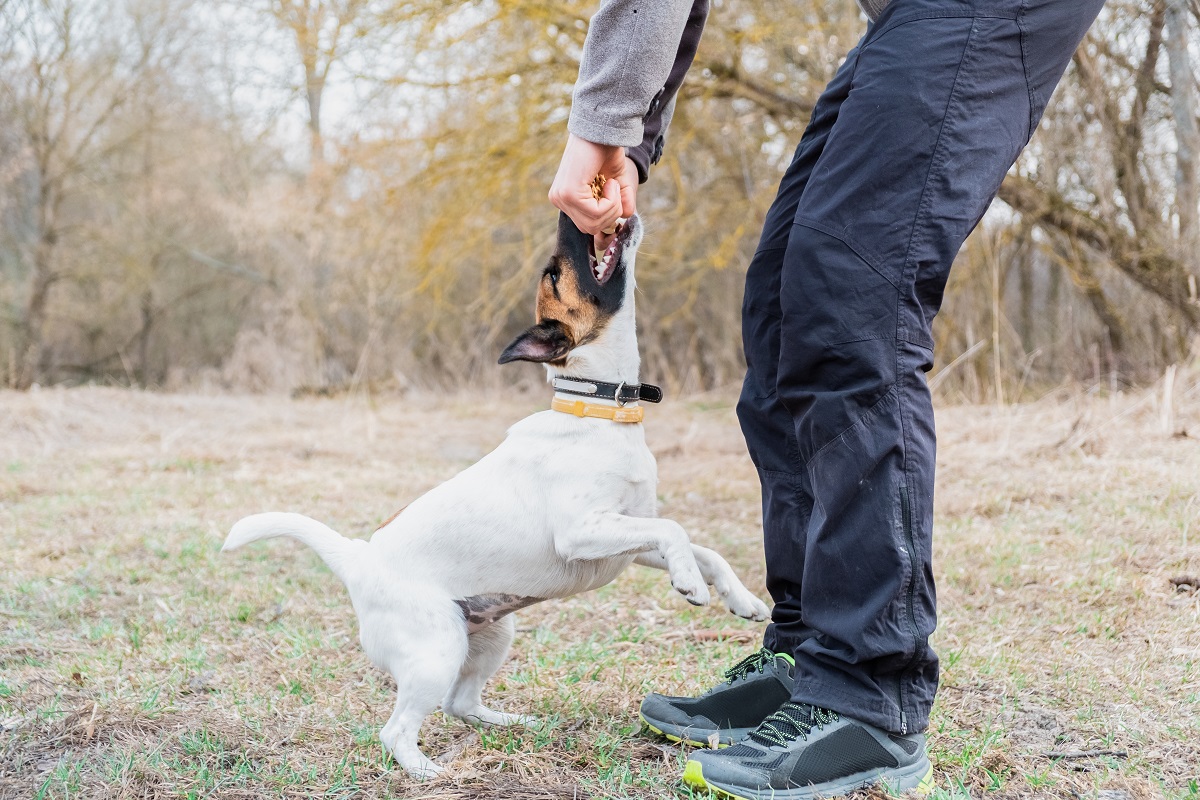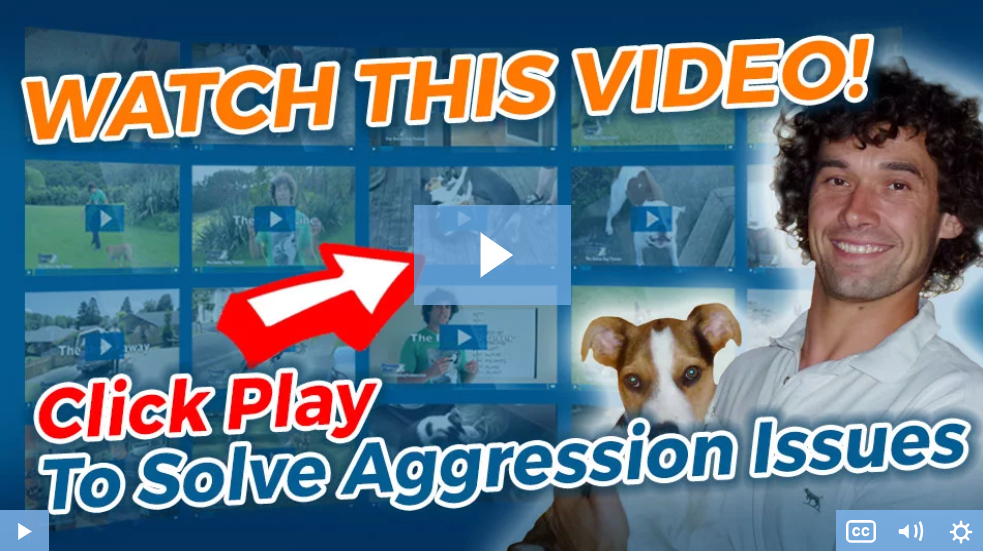“Why does my dog bite my hands?”
While this might seem like a bit of an odd question at first glance, a dog that loves nothing more than to nibble, chew, and constantly bite their owner’s hands is a very common occurrence.
And even though it’s considered natural, normal behavior during puppyhood, the story quite often changes when a fully grown adult dog decides to sink their teeth in.
Don’t get me wrong, a dog with an obsessive nibbling habit could very well be an innocent playtime gesture.
But a dog with a negative attitude and an underlying aggression issue is quite another. Which is why it’s also a habit that can take a turn for the worst if left unchecked.
Anyway, like most behavioral issues, biting is one of those things that needs to be nipped in the bud sooner rather than later.
The fix? …teach your dog to be calm and in control of their emotions. Especially if they bite out of excitement, aggression, fear, or anything else that is emotionally triggered.
So before you do anything else, I’d recommend checking out the 5 step-by-step calming exercises by Dan Abdelnoor over at The Online Dog Trainer. (see video below)
To put it bluntly, these specific exercises have stood the test of time when it comes to getting ANY dog to stay calm and in control.
The added benefit of this ’emotional control’ is that your dog will also become highly responsive. This basically means they’ll be far less likely to react to any situation that would normally cause them to bite in the first place.
So watch the video, implement the exercises, and you should see a vast improvement in your dog behavior for the better.
Here’s the video link to take a look: 5 Step-By-Step Calming Exercises To Stop Your Dogs Obsessive, Annoying Biting Habit…
(video will open in a new window)
Why Does My Dog Bite My Hands?
All dogs use their mouths for one reason or another. It’s ultimately how they explore new tastes and textures during puppyhood, so the idea that you should stop any mouthing behavior completely isn’t the point of this post.
The idea, however, is to teach your dog how to do it in a controlled way, where the end result doesn’t lead to a painful one.
Although there are multiple reasons your dog could be biting your hands (overexcitement, fear, etc.) It’s important to first understand why they’re exhibiting this potentially dangerous behavior, so you can put in place an effective plan to address it.
So take note of the following, do any ring a bell?
Teething
If you own an adult dog or older puppy, then this won’t apply. But teething pain in puppies is very real, which can often cause your pup to obsessively bite, gnaw and chew on anything and everything in sight.
As a rule of thumb, puppies usually start getting their baby teeth through at around 4-6 weeks of age.
By weeks 12-16, these baby teeth will slowly get replaced with their new ‘adult teeth,’ which should see them have a full new set by the time they’re 6 months old.
Like babies, puppies experience excessive pain and swollen gums when teething. So it’s no surprise that your pup may have a difficult time dealing with the process.
This will often lead to them biting everything they can sink their teeth into in an attempt to soothe the pain.
While this is expected to go away once they’re past the teething stage, some puppies carry the biting behavior to adulthood. So early intervention is needed once they’re past this stage to teach them that biting is not acceptable.
If possible, try to keep your puppy’s gums occupied by giving them plenty of other things to chew while also encouraging them to keep their mouth far away from your hands.
Play Mouthing
It’s no secret that dogs love to play. And while you might not think of biting as a form of play, your dog might think otherwise.
This type of behavior common in dogs that get easily excited or simply don’t understand how to calm down.
If this is the case, and your dog hasn’t mastered the art of controlling their mouthing behavior. Now would be a great time to revisit the 5 step-by-step calming exercises I mentioned earlier.
I guarantee that if you put what you learn into practice, your dog urge to bite will soon become a thing of the past.
Grooming Nibbles
Although it’s not common, some dogs may pick the behavior of grooming other animals, things, toys, and even your hands by gently nibbling with their incisors.
This behavior is considered affectionate, and dogs only do this to people they trust.
This particular type of nibble isn’t really considered dangerous, as you generally won’t feel their teeth when they’re displaying this behavior.
You’ll also notice that your dog is more relaxed, not wagging their tail or bounding around like an endless ball of energy compared to play mouthers.
They’re Overexcited
Dogs have different ways of showing excitement. Sometimes it is too much that you find your fingers locked on their jaws.
So if your dog only bites when they’re hyped up (for instance, when you come home from work), then it’s safe to say they bite out of excitement.
Again, while this particular behavior isn’t necessarily dangerous, it’s still something that should be discouraged if your dog lacks the capability to act upon it in a gentle, non-painful way.
A potential quick fix for this is to simply change how you react to the bite.
For instance, if you come home after a long day and instantly reward your dog with praise and attention while they’re attempting to bite. What you’re essentially doing is reinforcing the behavior.
It might be hard at first, but every time your dog bites, turn around and ignore them or, better still, leave the room entirely.
Once they understand that the behavior isn’t rewarded, they’ll be less inclined to bite in the future.
Related Post: How To Calm An Overexcited Dog – Instant Calming Techniques
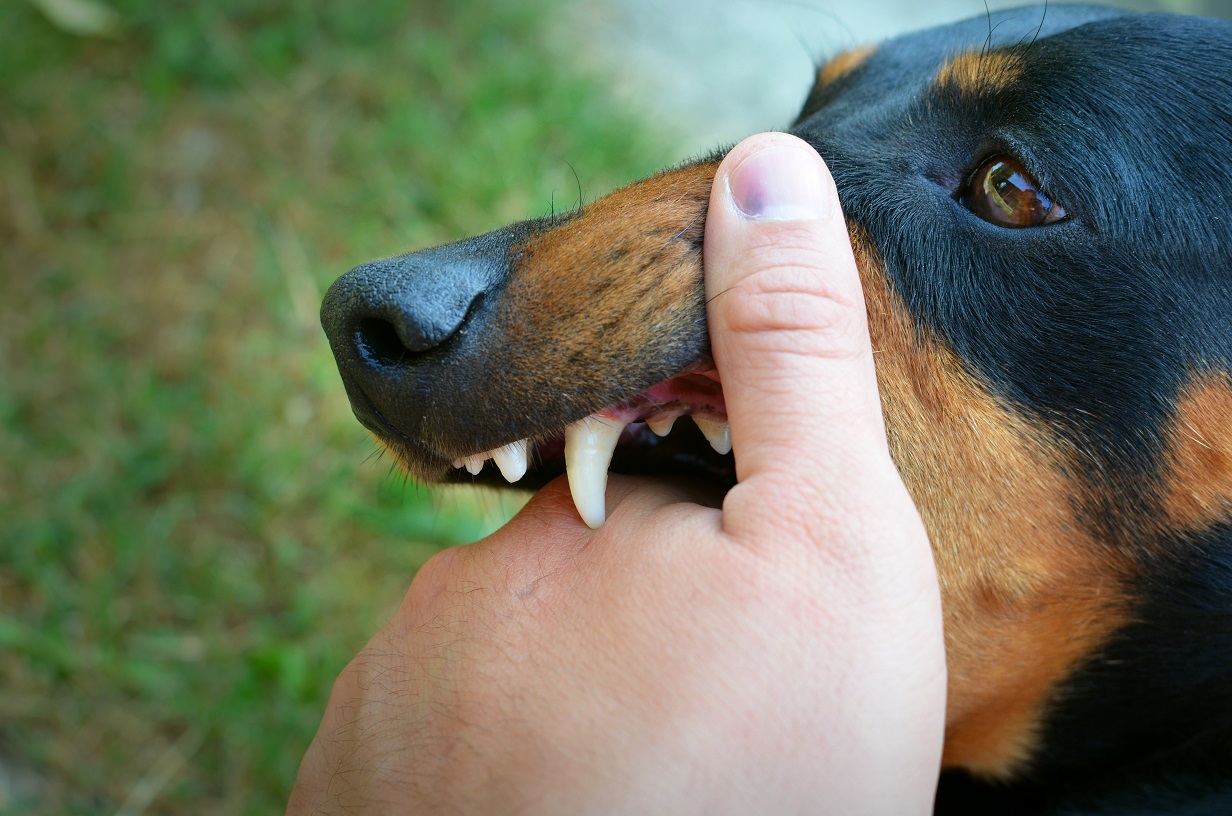
The Difference Between Play & Aggression
All biting isn’t created equal. And while we’d all love to think of the odd nibble as a way of your dog showing affection, this isn’t always the case.
Body language is usually a great indicator here as you’ll often find your dog demonstrating very clear differences in how they act when they’re biting.
For instance, a dog that’s acting in a playful (non-aggressive) way will usually exhibit the following behavioral traits…
- A relaxed posture accompanied by a wagging tail.
- Open mouth with their ears in a natural position.
- They might raise their bottom in anticipation of play.
- A high pitch non-threatening growl or bark.
On the flip side, an aggressive dog will display the following…
- Stiff posture and fixed stare.
- A low, deep growl that’s longer in duration.
- Their heckles will be raised.
- They may demonstrate a slight lip curl or even bare their teeth.
If you spot any of the aggressive signs above, it’s highly advisable to take a step back and give your dog a little space until the warning signs of aggression have disappeared.
In addition to this, you may want to seek help from a professional dog trainer to determine the cause of the aggressive behavior and train your dog safely.
Related Post: Why Does My Dog Bite Me When I Pet Him? – 5 Reasons Your Dog Bites
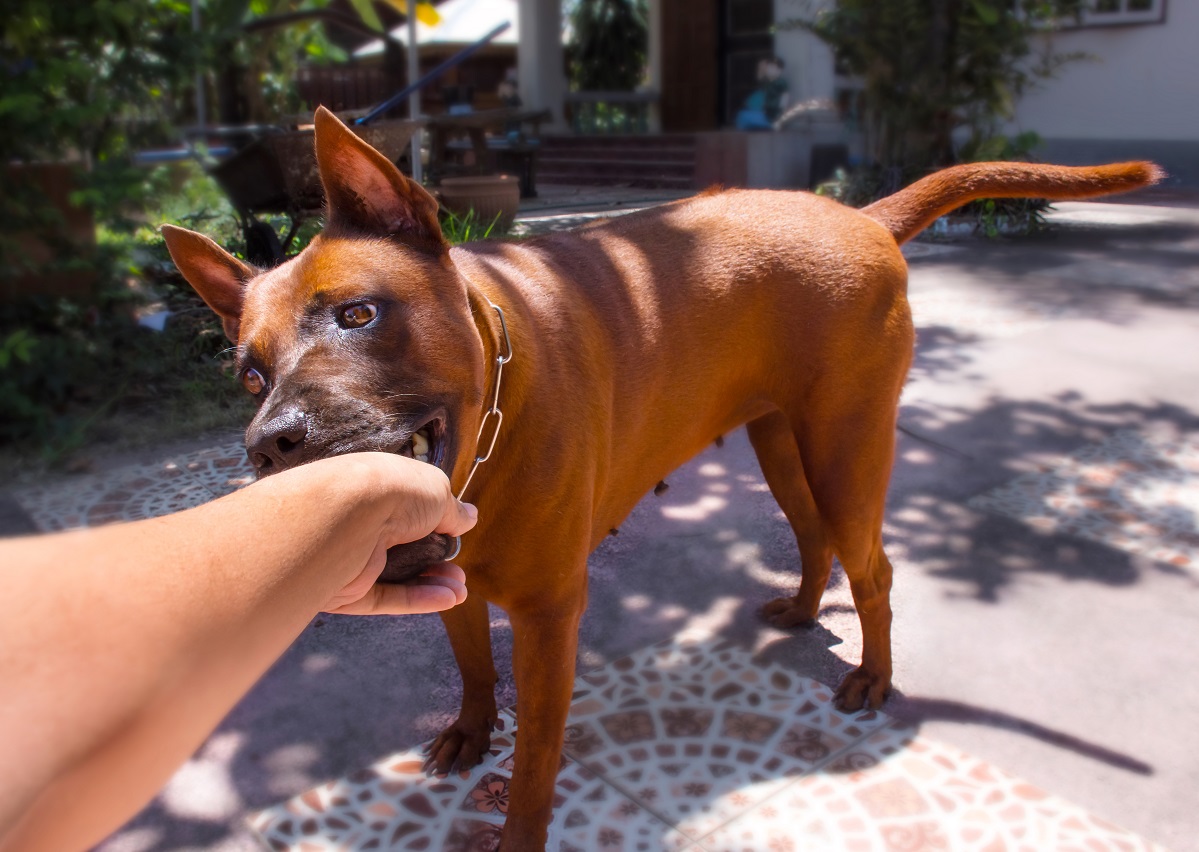
How To Stop Your Dog Biting Your Hands
Once you’ve established why your dog is biting your hands, the next step is developing a strategy to manage it effectively.
But let’s just be clear, while most forms of biting are both unwanted and unnecessary. It’s still part of your dog’s natural defense.
So the aim here isn’t to eliminate biting completely. It’s more about teaching your dog what is and isn’t appropriate when it comes to chewing away at your fingers.
To curb the behavior, you’ve got multiple options. Each of which will differ in effectiveness depending on the nature of your dog and how you apply each of the techniques below.
Just remember that every dog is unique and what works for one might not work for another and vice versa.
Anyway, without further ado, let’s take a look at how to nip this problem in the bud (no pun intended) once and for all.
First up…
Figure Out The Root Cause
To learn why your dog bites your hands, it’s first important to spend a little time understand what makes them tick.
You can start by trying to remember when your dog started exhibiting this type of behavior before deciding on a conclusion as to why it’s happening.
For instance, if they’ve displayed their biting habits since puppyhood, it could just be an instinctively learned behavior that they’ve carried through with them to their adult years.
And while not impossible to rectify, it can take a little work to discourage this ingrained behavior and start seeing an improvement in their ability to refrain from biting.
Anyway…
Before running through the solutions below, I’d highly recommend familiarizing yourself with the 5-step-by-step calming exercises we talked about earlier.
While they won’t instantly solve your dog’s persistent biting habit, they will put your dog in a highly responsive, relaxed state where they’ll be much more likely to listen and obey.
Once you’re done, work your way through the following…
Teach Them Bite Inhibition
Although it’s a lot easier to teach bite inhibition while your dog is still young. It’s by no means impossible with an older, more mature dog.
Just to give you a little insight, bite inhibition is your dog’s ability to control force when biting to avoid injuring or hurting others.
A dog who hasn’t learned bite inhibition doesn’t recognize the sensitivity of human skin. Which means they could be more prone to biting hard, even if it wasn’t intentional.
Dogs that have learned this behavior are far more gentle and a lot less likely to bite with vicious intent unless absolutely necessary.
Again, dogs usually learn play inhibition at a younger age (usually through play with other dogs).
For instance, when dogs play by bite each other, and the victim yelps and stops playing, the attacker picks up on this behavior and learns that biting stops the game.
In time, they start to exercise a little restraint and learn to control the intensity of their bites.
To make this work for your dog’s obsession with your hands, it’s simply a case of repeating the same behavior by letting out a short sharp yelp whenever they bite.
Show Them It’s Not Appreciated
Being the intelligent animals they are, dogs will often recognize particular behavioral patterns that you display and act accordingly.
For instance, if you tend to laugh, smile, or even make funny faces at your dog after a bite, they’ll pick up on this and think it’s OK to continue the behavior.
It sounds simple, I know, but the next time your dog bites your hands, let your hand go limp and imitate the yelping sound.
You could even increase the effectiveness of this method by turning your back on your dog or even leaving the room entirely for a few minutes.
The idea here is to avoid giving your dog a positive reaction that will make them repeat the behavior.
Once they realize it’s game over, they’ll be less inclined to bite next time around.
Use Distractions
It sounds obvious, but instead of availing your hands for a bite, give your dog something they could bite. Whether you are training a puppy or even an adult dog, this easy redirection method works for all ages.
Here’s how it works…
Each time your dog makes an attempt at biting, pull your hand away and provide a chew toy or treat for them to nibble on instead.
In addition to this, I’d recommend avoiding games that allow too much skin contact. So consider an alternative like a simple game of fetch or tug-of-war.
If you need more ideas, a great alternative would be to take a look at the Brain Training For Dogs Program. They’ve got some pretty cool games you can teach to keep them distracted for hours on end.
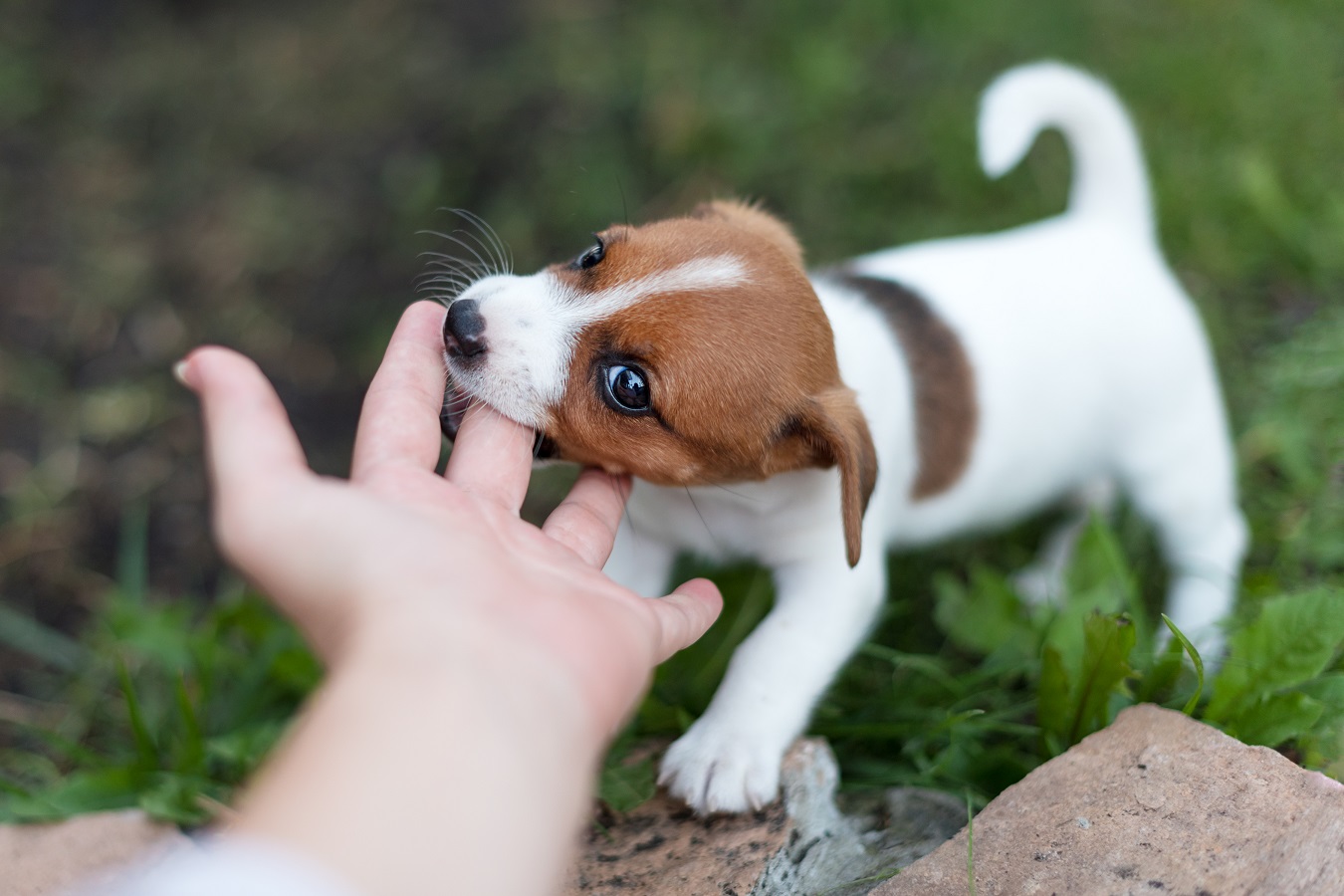
Wrapping Things Up
While not necessarily dangerous, a dog that loves nothing more than to nibble, gnaw and chew your hands isn’t exactly desirable.
Worst still, it’s something that, if left unchecked, can lead to a lot more complications further down the line.
The reality is that there are too many other things they could sink their teeth into instead. So do yourself a favor and encourage your dog to opt for a toy or bone instead of your precious hands.
Remember, a behavior that is not reinforced will stop. So do your best to avoid any type of praise or attention that revolves around your dog’s persistent biting, and it should slowly start to become a thing of the past.
